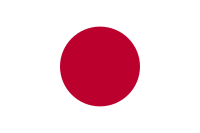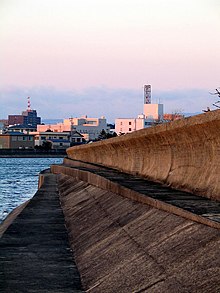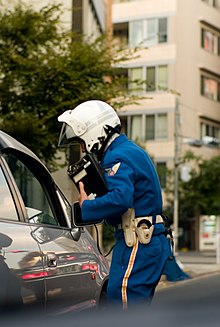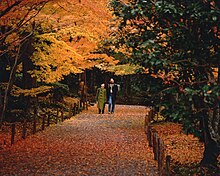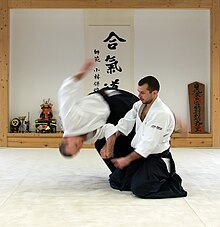Overview of and topical guide to Japan
An enlargeable map of Japan The following outline is provided as an overview of and topical guide to Japan :
Japan – an island nation in East Asia , located in the Pacific Ocean . It lies to the east of the Sea of Japan , China , North Korea , South Korea and Russia , stretching from the Sea of Okhotsk in the north to the East China Sea and Taiwan in the south. The characters that make up Japan's name mean "sun-origin" (because it lies to the east of nearby countries), which is why Japan is sometimes referred to as the "Land of the Rising Sun ". Japan is an archipelago of 14,125 islands . The four largest islands are Honshu , Hokkaido , Kyushu , and Shikoku , which together comprise about ninety-seven percent of Japan's land area.
General reference
Geography of Japan
An enlargeable topographic/hydrographic map of Japan An enlargeable map of the extreme points of Japan
Environment of Japan
An enlargeable satellite image of Japan Mount Ontake seen from Kurakake Pass
Geographic features of Japan
An enlargeable map of the World Heritage Sites of Japan
Regions of Japan
Tsunami wall at Tsu, Mie The four main islands of Japan are:
Major regions of Japan include:
Hokkaido (the island of Hokkaido and nearby islands, largest city Sapporo )Tōhoku region (northern Honshu , largest city Sendai )Kantō region (eastern Honshu, largest cities Tokyo and Yokohama )
Chūbu region (central Honshu, including Mount Fuji ), sometimes divided into:
Kansai or Kinki region (west-central Honshu, largest cities Osaka , Kobe , and Kyoto )Chūgoku region (western Honshu, largest city Hiroshima , and Okayama )Shikoku (island, largest city Matsuyama , and Takamatsu )Kyushu (island, largest city Fukuoka ) which includes:
Ecoregions of Japan
Administrative divisions of Japan
Administrative division types
Prefectures of Japan
Map of the prefectures of Japan in ISO 3166-2:JP order and the regions of Japan From north to south (numbering in ISO 3166-2:JP order), the prefectures of Japan and their commonly associated regions are:
Karafuto , a portion of the island of Sakhalin north of Hokkaido (not shown on the map), was part of Japan from 1907 until World War II. The entire island is now governed by Russia .
Municipalities of Japan
Cities of Japan
Demography of Japan
Government and politics of Japan
Naruhito , 126th Emperor of Japan
Branches of the government of Japan
Executive branch of the government of Japan
Present-day Kantei
Legislative branch of the government of Japan
National Diet Building
Judicial branch of the government of Japan
Foreign relations of Japan
Dish of whale meat
International organization membership of Japan
Japan is a member of:[ 3]
Law and order of Japan
Motorcycle policeman questioning driver
Military of Japan
History of Japan
Japanese bushi
History of Japan by period
Culture of Japan
Japanese tea ceremony Woman in kimono at Fukuoka City Hall
Architecture of Japan
Himeji Castle (UNESCO World Heritage Site)
Art of Japan
Kyoto geiko playing shamisen Bugaku Bankei Yōtaku calligraphyNoh mask, Bern Historical Museum
Cuisine of Japan
A traditional Japanese breakfast Kuzumochi
Cultural icons of Japan
Sōraku-en rhododendron gardenSakura at Tsu Castle
Fashion in Japan
A woman wearing kimono
Holidays and festivals of Japan
Momijigari Ryōan-ji in Kyoto
Homes in Japan
Byōbu Sōgetsu-ryū ikebana Shōji
Language in Japan
People of Japan
Ethnicity in Japan
Stereotypes in Japan
A geisha and a maiko dancing
Religion in Japan
Sports and gaming in Japan
Aikido , a modern Japanese martial art
Economy and infrastructure of Japan
Lexus LF-LC concept, a two-door coupé produced by Lexus Tokyo Skytree , the tallest structure in Japan Economy of Japan
Zaō Quasi-National Park Shinkansen
Education in Japan
Japanese junior high school students in sailor outfit-style school uniforms
Structure of education in Japan
Health in Japan
Science and technology of Japan
JAXA Kibo , the largest module for the International Space Station
See also
Notes
^ The Emperor has no executive authority, but is treated as a head of state under diplomatic protocol
^ While the Yamato period (250–710 CE) is considered to include both the Kofun and Asuka periods, as it spans both an archaeological period (Kofun) and a historical period (Asuka), it is held by many to be an outdated period of division in Japan's history, and no longer applicable in discussions of period division.
References
External links
Wikimedia Atlas of Japan
Official
Tourism
Other
